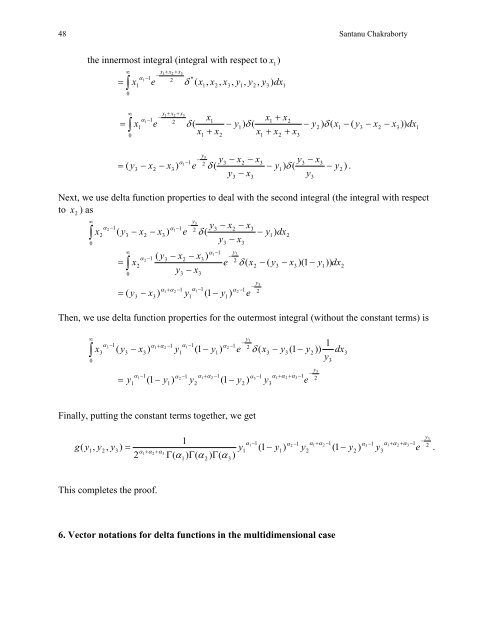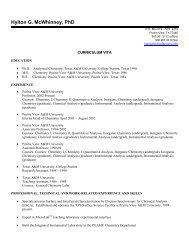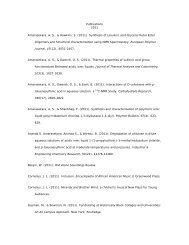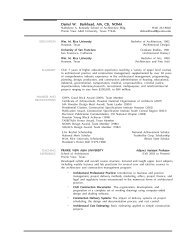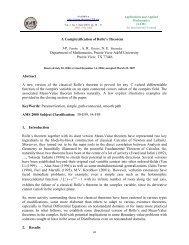Some applications of Dirac's delta function in Statistics for more than ...
Some applications of Dirac's delta function in Statistics for more than ...
Some applications of Dirac's delta function in Statistics for more than ...
Create successful ePaper yourself
Turn your PDF publications into a flip-book with our unique Google optimized e-Paper software.
48 Santanu Chakraborty<br />
the <strong>in</strong>nermost <strong>in</strong>tegral (<strong>in</strong>tegral with respect to x 1)<br />
∞ x1<br />
+ x2<br />
+ x3<br />
α1−1<br />
−<br />
2 *<br />
= ∫ x1<br />
e δ ( x1,<br />
x2<br />
, x3,<br />
y1,<br />
y2<br />
, y3<br />
) dx1<br />
0<br />
= ∫<br />
∞ x1<br />
+ x2<br />
+ x3<br />
α1−1<br />
− x<br />
2<br />
1<br />
x1<br />
+ x2<br />
x1<br />
e δ ( − y1)<br />
δ (<br />
− y2<br />
) δ ( x1<br />
− ( y3<br />
− x2<br />
− x3<br />
)) dx1<br />
x<br />
0<br />
1 + x2<br />
x1<br />
+ x2<br />
+ x3<br />
y<br />
3<br />
−<br />
α1−1<br />
y3<br />
− x2<br />
− x<br />
2<br />
3 y3<br />
− x3<br />
= ( y3<br />
− x2<br />
− x3<br />
) e δ (<br />
− y1)<br />
δ ( − y2<br />
) .<br />
y − x<br />
y<br />
3<br />
Next, we use <strong>delta</strong> <strong>function</strong> properties to deal with the second <strong>in</strong>tegral (the <strong>in</strong>tegral with respect<br />
to x 2 ) as<br />
∞<br />
y3<br />
α −<br />
−<br />
− − −<br />
2 1<br />
α 1 y3<br />
x<br />
2<br />
2 x<br />
1<br />
3<br />
∫ x2<br />
( y3<br />
− x2<br />
− x3<br />
) e δ (<br />
− y1)<br />
dx2<br />
y − x<br />
0<br />
3 3<br />
∞<br />
α1−1<br />
y3<br />
α 1 ( 3 2 3)<br />
2 − y − x − x −<br />
2<br />
∫ x2<br />
e ( x2<br />
− ( y3<br />
− x3<br />
)( 1−<br />
y1))<br />
dx2<br />
y<br />
0<br />
3 − x3<br />
y3<br />
1<br />
−<br />
α1<br />
+ α 2 −1<br />
α1−<br />
α 2 −1<br />
2<br />
( y3<br />
− x3<br />
) y1<br />
( 1−<br />
y1)<br />
e<br />
= δ<br />
=<br />
Then, we use <strong>delta</strong> <strong>function</strong> properties <strong>for</strong> the outermost <strong>in</strong>tegral (without the constant terms) is<br />
∞<br />
∫<br />
0<br />
x<br />
y3<br />
α −1<br />
−<br />
−<br />
+ −1<br />
1<br />
−1<br />
1<br />
3 α1<br />
α 2 α1<br />
α 2 2<br />
3 ( y3<br />
− x3<br />
) y1<br />
( 1−<br />
y1)<br />
e δ ( x3<br />
− y3<br />
( 1−<br />
y2<br />
)) dx3<br />
y3<br />
y3<br />
α1<br />
−1<br />
1<br />
1<br />
1<br />
1<br />
−<br />
α 2 − α1+<br />
α 2 −<br />
α3<br />
− α1+<br />
α 2 + α3<br />
− 2<br />
= y1<br />
( 1−<br />
y1)<br />
y2<br />
( 1−<br />
y2<br />
) y3<br />
e<br />
F<strong>in</strong>ally, putt<strong>in</strong>g the constant terms together, we get<br />
g(<br />
y1,<br />
y2<br />
, y3<br />
) =<br />
2<br />
1+<br />
α 2 + α3<br />
This completes the pro<strong>of</strong>.<br />
α<br />
1<br />
y<br />
Γ(<br />
α ) Γ(<br />
α ) Γ(<br />
α )<br />
1<br />
2<br />
3<br />
3<br />
α1−1<br />
1<br />
( 1−<br />
y<br />
α 2 −1<br />
α1+<br />
α 2 −1<br />
1)<br />
y2<br />
6. Vector notations <strong>for</strong> <strong>delta</strong> <strong>function</strong>s <strong>in</strong> the multidimensional case<br />
3<br />
( 1−<br />
y<br />
y3<br />
1<br />
1<br />
−<br />
α3<br />
− α1+<br />
α 2 + α3<br />
− 2<br />
2 ) y3<br />
e<br />
.


